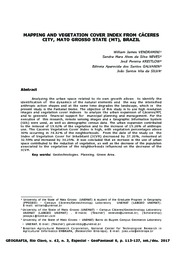Mapping and vegetation cover index from cáceres city, Mato Grosso State (MT), Brazil.
Mapping and vegetation cover index from cáceres city, Mato Grosso State (MT), Brazil.
Author(s): VENDRAMINI, W. J.; NEVES, S. M. A. da S.; KREITLOW, J. P.; GALVANIN, E. A. dos S.; SILVA, J. dos S. V. da
Summary: Analyzing the urban space related to its own growth allows to identify the identification of the dynamics of the natural elements and the way the intensified anthropic action shapes and at the same time degrades the landscape, which in the present study is the Pantanal biome. The objective of this study is to use high resolution images and vegetation cover indexes to analyze the urban expansion of Cáceres/MT, and to generate financial support for municipal planning and management. For the execution of this research, remote sensing images and a Geographic Information System (GIS) were used, as well as demographic census data. The urban expansion contributed to the removal of 19.62% of the vegetation and to the increase of 15.28% of anthropic use. The Caceres Vegetation Cover Index is high, with vegetation percentages above 30% occurring in 74.42% of the neighborhoods. From the date of the study on the Index of Vegetation Cover for Inhabitant (ICVH) decreased by 37.20%, remained at 32.55% and increased by 30.25%. It was concluded that an increase in the use of urban space contributed to the reduction of vegetation, as well as the decrease of the population associated to the vegetation of the neighborhoods influenced on the decrease of the ICVH.
Publication year: 2017
Types of publication: Paper in annals and proceedings
Observation
Some of Embrapa's publications are published as ePub files. To read them, use or download one of the following free software options to your computer or mobile device. Android: Google Play Books; IOS: iBooks; Windows and Linux: Calibre.
Access other publications
Access the Agricultural Research Database (BDPA) to consult Embrapa's full library collection and records.
Visit Embrapa Bookstore to purchase books and other publications sold by Embrapa.

